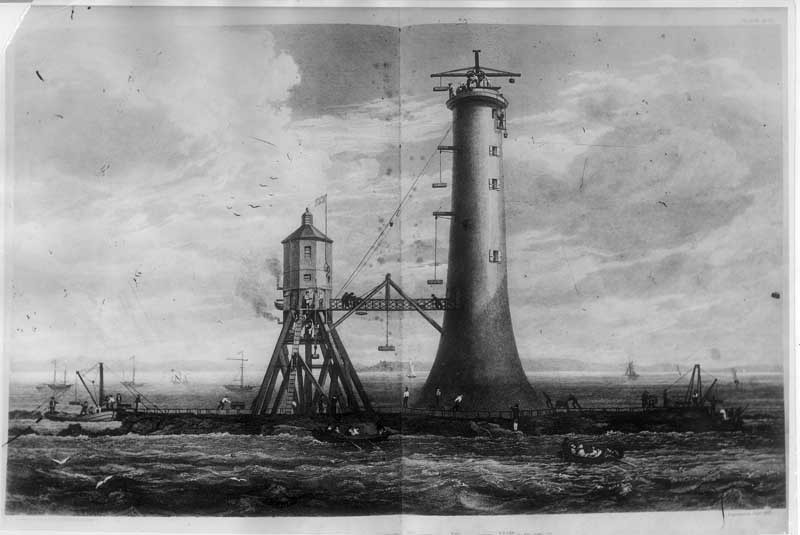On February 1, 1811, the lanterns of the Bell Rock lighthouse were lit for the first time, shining out into the dark North Sea. Over the last 200 years its beacon has saved countless lives by alerting vessels to the deadly rocks that lie just below the surface of the water 11 miles off the cost of Arbroath.
To coincide with the bicentenary there are a number of events taking place both locally and nationally, including the Year of the Light celebrations in Arbroath, while a BBC Scotland television programme will explore the history of the Stevenson dynasty, which wsa responsible for designing and building a network of lighthouses around the coast of Scotland.
The Lighthouse Stevensons charts the work of the family over the course of five generations, from the late 1700s to the early 1900s, constructing lighthouses on some of Scotland’s most storm-lashed and inaccessible outcrops.
The family tradition began with Thomas Smith, who installed his first light on Kinnaird Castle, near Fraserburgh, in 1787. He passed the baton on to his son-in-law, Robert Stevenson who built the Bell Rock between 1807 and 1811 and who founded a dynasty of lighthouse engineers that included his sons, Alan, David and Thomas (father of the author Robert Louis Stevenson) and, in turn, David’s sons David A. and Charles and, finally, Charles’s son D. Alan.
The film, produced by Caledonia TV and narrated by Denis Lawson, takes viewers through their remarkable achievements and the strange world of lighthouse-keeping including its strains on family life through to modern-day automation.
Other lighthouses featured include Kinnaird Head now home to the Museum of Scottish Lighthouses Skerryvore, off Tiree, Muckle Flugga, north of Shetland, and Dhu Heartach, west of Mull. The programme also features interviews with former keepers.
Author and journalist Bella Bathurst was so interested in the history of the Stevenson family that she wrote a book called The Lighthouse Stevensons.FascinationAs part of the documentary, she was taken out to the Bell Rock by a Northern Lighthouse Board helicopter to be interviewed about her fascination with the generations of famous engineers.
“It was absolutely magic,” she said. “It was fantastic to be able to go there. I had been to Skerryvore, which is the great light on the west coast built by Robert Stevenson’s eldest son, Alan, but I hadn’t been to the Bell although I had written about it.
Although the television programme takes the same name as her book, it isn’t a dramatisation of the text.
“They wrote to me and asked if I would mind them taking the same name and I said no, because if you want to describe what the Stevensons did there’s no better way of doing it.
They were even known as the ‘Lighthouse Stevensons’ at the time and they had to be separated from the Stephensons, who were the great railway engineers, and who were their contemporaries.”
Born in London, Bella’s mother is from Biggar in South Lanarkshire, so she has always had a family connection with Scotland. She studied at Durham University and was first employed in publishing before working in Edinburgh as a journalist in her 20s.
“After this, I went down to London and started writing The Lighthouse Stevensons. It was the right moment to do so because it was just before the last of the lights were automated, so I was able to interview that generation of keepers.”
The process of de-manning and automating all Scotland’s lighthouses by the Northern Lighthouse Board was a slow and complex operation that spanned decades.
The Bell Rock became automated in 1988 and the last was Fair Isle South in March 1998.
Bella was drawn to the Stevensons after paying a visit to The Science Museum in London, where she saw a beautiful, revolving Victorian lighthouse lens.Robert Louis Stevenson”I was dimly aware that Robert Louis Stevenson had a connection with engineering, but it wasn’t something that leapt into focus until I went to the museum. I remember it said the light was originally at St Abbs Head and was built by Robert Stevenson.
“I went down to the bookshop afterwards to see if they had any books on the Stevensons, and they couldn’t find any that had been published. I went home and read up what I already had on Robert Louis Stevenson and I realised he had this amazingly complex relationship with his family’s profession in engineering and that he’d got out.
“In his case it was a really healthy decision. I think he realised he wasn’t physically strong enough to be able to do it, and he was being pulled towards something else.
“I think his uncle Alan had the same kind of fundamental physical health problems and was just as gifted as a scholar, but was unable to resist the pull of his father and the drive to become an engineer. He became the greatest of the Stevensons he built Skerryvore.”
The Lighthouse Stevensons won The Somerset Maugham Award and was shortlisted for the Guardian First Book Award.
Bella went on to write another book called The Wreckers (2005), a history of shipwrecking and skulduggery around the coast of Britain.
“When I was researching the Lighthouse Stevensons I came across the wreckers, because they resisted the building of the lighthouses. They wanted to ensure there were plenty of shipwrecks, because it affected the livelihoods of people living in more remote places.”
She will give a talk about the Bell Rock and the Stevensons at The Hub on Edinburgh’s Royal Mile on Tuesday evening, and is also hoping to attend a bicentenary conference organised by The Royal Society of Edinburgh on Friday.
“I am going to come back to writing about the sea I don’t think I can avoid it. I am going to write about modern seafaring and what’s it’s like to work at sea today.”
The Lighthouse Stevensons is on BBC Two Scotland tomorrow at 9pm.
Find out more about the Bell Rock bicentenary celebrations at www.angusahead.com/bellrocklighthouse.
